
I recently conducted an interview with ReachForce on the subject of ‘using data to improve Customer Experience’ – here is what I had to say…
How did you become so passionate about customer experience management?
In reality, I think I must have been born with a passion for CX! Apart from it being in my genes…. my very makeup, my evolution into the CX Specialist that I am now started at the end of the 90s. I was working as a process improvement specialist for General Electric – I was bowled over by the power of Jack Welch and his ideas. Using tools and methodologies to improve the ability of a business to meet and exceed customer expectation just made so much sense to me. I took a role as a Six Sigma Black Belt…. the rest is history!
Why is it so important for businesses today to focus on customer experience?
Ultimately, every business in the world has been delivering a customer experience since the beginning of time – it is only in recent years that organizations have become conscious of that fact. Ultimately, we now live in a world of increasingly demanding customer expectations; increasing competition and continuous market disruption (economic and technological) – ultimately, it is now VERY difficult for any company to differentiate on its products and services alone.
What a customer remembers about you is the way the EXPERIENCE interacting with you made them feel – it is this feeling that will determine their future interaction with you. Failure to understand this and constantly improve and adapt the experience to leave customers feeling the way you WANT them to feel is potentially fatal.
What are some outdated ideas or methods you’ve come across as they relate to customer experience?
There are a number!! The most common ones are as follows:
1. Confusion between Customer Service, Customer Experience and Customer Centricity – they are not the same thing! I have written about this.
2. Drawing the wrong conclusion from poorly executed customer feedback mechanisms – specifically, failing to measure the TRUE end to end customer journey.
3. Failure to have the resource or capability to actually IMPROVE customer focused priorities.
4. Lack of governance and ownership
I could go on and on and on!
What brands have you come across that you believe have done an especially noteworthy job providing first-class customer experience? What can we learn from them?
The examples are very often all too few and obvious! Amazon is the master of the consistently easy customer experience – they have removed so much effort, that it is difficult for customers to justify “bothering” to go anywhere else!
The Ritz Carlton will always be an excellent benchmark for anyone to follow – whilst they are a premium brand, much of what underpins their approach to CX costs nothing – it is a mindset.
Moo.com is a brilliant example of a much smaller business that does things brilliantly – have a read of this article to find out why.
Where should brands begin when creating a strategy to improve customer experience?
Without question, the starting point is to create a connection between business strategy and customer strategy – or in other words – what the business wants and what the customer wants. It is so important to connect the whole organization to a common PURPOSE (Why do we exist? How are we going to enable our purpose to happen? What is it that brings our purpose to life? (products and services). Simon Sinek’s Golden Circle is a must read for anyone who is just embarking on their CX journey.
How should brands be using data to measure the success or failure of their customer experience strategy?
CX is NOT a soft and fluffy “fad” – in fact, the best CX programs are the ones who have been able to embed what I call “measurement or the facts” into their CX framework.
I teach and talk about the importance of driving three “voices” or measurement into a business – Voice of the Customer, Voice of the Process AND Voice of the Employee – what is critical is that the way you measure CX MUST be reflective of “the truth” AND of the end to end customer journey. Too many organizations are driven by having an ego massaging NPS scvore – the score means NOTHING unless you have absolute clarity as to how good or bad your customer journey is at bringing your purpose to life and what your priorities for improvement are.
What types of data do you believe brands put too much emphasis on when it comes to customer experience?
See above – the NPS score is not the be all and end all – at the same time, focusing too much on internally focused KPIs is also a bad thing.
What tools or innovations are you most excited about for how they can offer brands insight on what their customers like, dislike and want?
That is a trickier question. I think the evolution of newer methodologies such as “design thinking” is hugely exciting – BUT – there are still so many organizations that are such a long way from even starting their CX journey … and as a result getting the very basic of basics right, that my honest view is that all businesses just need to keep their approach to CX as simple and as focused as possible!
In a way, the best innovation of all is the recognition that CX is now a profession – the growing band of experienced, qualified CX professionals is what will ultimately benefit customers, employees and shareholders the most.
ReachForce helps B2B marketers increase revenue contribution by providing continuous data quality management through database profiling and cleanup, inbound lead form data enrichment, and data cleansing and appending. They partner with B2B marketers to deliver better demand generation & customer lifecycle marketing results through data management.
You can read the original interview here.
Get a free data assessment from ReachForce today.






Leave A Comment